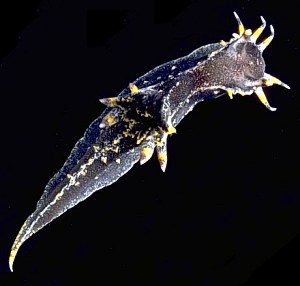
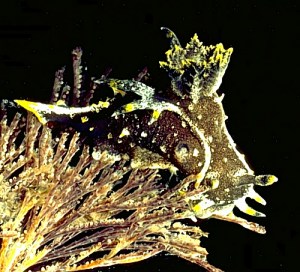
Polycera hedgpethi
Marcus, 1964
Order: NUDIBRANCHIA
Suborder: DORIDINA
Family: Polyceridae
Subfamily: Polycerinae
DISTRIBUTION
Natural distribution unknown. First described from California, where it is found from Marin County, California to Baja California, Mexico. It is also known from port regions in South Africa, West Africa, northern New Zealand, and in Australia from Mallacoota, (northern Victoria), Sydney (New South Wales) and one report from Albany (Western Australia). Also recorded from the Mediterranean (See below), Spain, and Japan.
PHOTO
Botany Bay, Sydney, New South Wales, June 1980, on bryozoan growth fouling the bottom of a mussel raft. Lower photo on bryozoan, Bugula sp. Length 15mm.
PHOTOS: Bill Rudman.
A typical Polycera, it has a frontal veil bearing 4-6 pointed processes which are white-tipped with an upper band of gray-black and a lower one of yellow. Its body is covered with black or grey speckling. The ridges between rhinophores and gills, and gill to tail are clear of specks and appear white to yellow. The rhinophore club has a black lower, and a yellow upper band, and the gills are grey or blackish with yellow tips. The extra-branchial appendages are similar in colour to the anterior frontal veil processes.
Polycera hedgpethi is an interesting member of the fouling community associated with the bryozoan Bugula. Its present distribution around major seaports on the edge of the Indo-West Pacific suggest its present distribution is the result of shipping rather than natural causes. A similar story is found with Thecacera pennigera. It grows to 20-25mm long. It has a wide spiral egg ribbon with small white eggs.
Reference:
• Behrens, D.W. (1980) Pacific Coast Nudibranchs. A guide to the opisthobranchs of the northeastern Pacific. Sea Challengers. Los Osos, California
• Caballer, M. & Ortea, J. (2002) Primera cita de Polycera hedgpethi Marcus, 1964 (Mollusca: Opisthobranchia) para la Península Ibérica. Noticiario SEM, 37: 55-56.
• Cervera, J.L. et al. 1988 (1991). Polycera hedgpethi Marcus, 1964 (Gastropoda; Nudibranchia), una especie indopacifica descubierta en el Mediterraneo. Iberus, 8(2): 225-231.
• Marcus, E.R. (1964). A new species of Polycera (Nudibranchia) from California. The Nautilus, 77(4): 128-131
• .Miller, M.C. (2001) Descriptions of the Dorid nudibranchs Polycera hedgpethi Marcus, 1964 and P. fujitai Baba, 1937 in New Zealand (Gastropoda: Opisthobranchia). Journal of Molluscan Studies, 67: 489-497.
• Valles, Y., Valdes, A. & Ortea, J. (2000) On the phanerobranch dorids of Angola (Mollusca, Nudibranchia): a crossroads of temperate and tropical species. Zoosystema, 22(1): 15-31.
Rudman, W.B., 1999 (July 22) Polycera hedgpethi Marcus, 1964. [In] Sea Slug Forum. Australian Museum, Sydney. Available from http://www.seaslugforum.net/find/polyhedg
Related messages
Polycera hedgpethi from California
November 3, 2008
From: Phil Garner
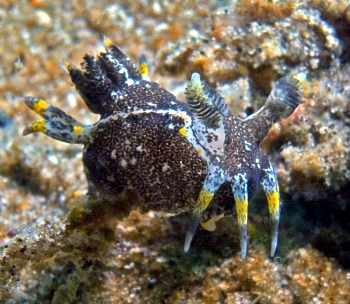
Concerning message #1113:
Polycera hedgpethi has been high on my want-to-find list until last weekend. My fiancee found one while we were diving in Redondo Canyon. After taking numerous photos, I spotted another nearby!
Locality: Redondo Beach, 10 meters, California, USA, Pacific Ocean, 26 October 2008, Sandy canyon. Length: 2 cm. Photographer: Phil Garner.
Phil Garner
PacificCoast101@yahoo.com
Garner, P., 2008 (Nov 3) Polycera hedgpethi from California. [Message in] Sea Slug Forum. Australian Museum, Sydney. Available from http://www.seaslugforum.net/find/22002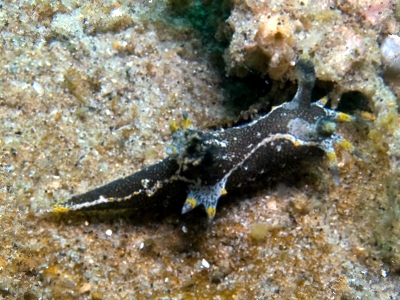
Thanks Phil,
This is one of those interesting 'tramp' species which apparently 'hitchhike' their way around the world on shipping and perhaps floating debris. They are of course dependent on supplies of their food bryozoa, which also spreads around the world in the same manner.
Although we don't know where it actually originated, its always nice to get another record from California - the place the species was first described from.
Best wishes,
Bill Rudman
Polycera hedgpethi from Western Australia
April 1, 2008
From: Brent Murdoch
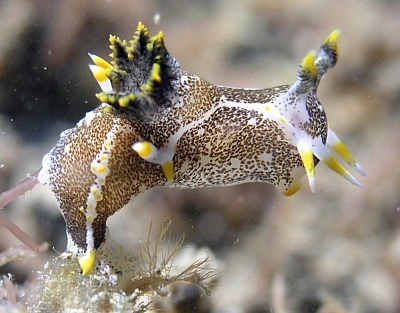
Hi Bill,
I have found a pocket of these, must be the right time of year. In your Forum they are listed as rare and that you could not get any specimens when you went back to have a second look. Do you still want some specimens?
Locality: Swan River, Fremantle, 5 m, Western Asutralia, Indian, 19 October 2007, Sandy bottom. Length: 7 mm. Photographer: Brent Murdoch.
Regards
Brent
brent@murdoch.id.au
Murdoch, B.D., 2008 (Apr 1) Polycera hedgpethi from Western Australia. [Message in] Sea Slug Forum. Australian Museum, Sydney. Available from http://www.seaslugforum.net/find/21003Thanks Brent,
Its not so much that these animals are 'rare' but that they are unpredictable. Their presence is totally dependent on the presence of their food bryozoans. Thanks for the offer of specimens but I have no direct research interest at the moment, butyou may be contacted someone studying the population genetics and distribution of these 'hitchhikers' for an animal for DNA studies.
Best wishes,
Bill Rudman
Polycera hedgpethi from Western Australia
March 12, 2007
From: Bruce Potter
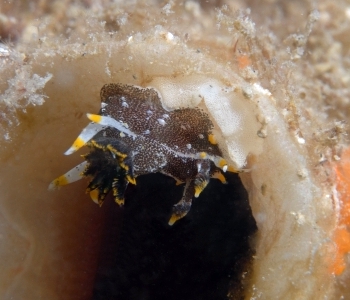
Dear Bill,
On my recent trip to Rockingham WA I found many examples of Polycera hedgpethi. This one was interesting in that it was laying eggs. It would have been about 15mm long at a depth of about 6 metres in a very mucky environment under a jetty.
Locality: Rockingham, 6 metres, Western Australia, Indian Ocean, 24 February 2007, Mucky under Jetty. Length: 15mm. Photographer: Bruce Potter.
Regards
Bruce Potter.
bandppotter@bigpond.com
Potter, B., 2007 (Mar 12) Polycera hedgpethi from Western Australia. [Message in] Sea Slug Forum. Australian Museum, Sydney. Available from http://www.seaslugforum.net/find/19600Thanks Bruce,
Bill Rudman
Polycera hedgpethi? from Victoria, Australia
December 19, 2006
From: Martin Hing
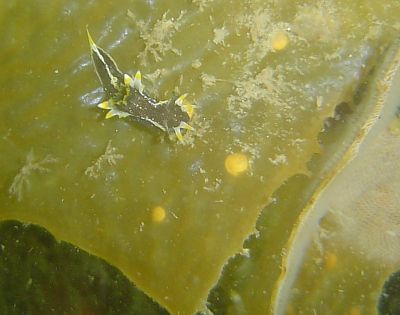
Hi Bill,
Could you please help me identify this species? I think it is Polycera hedgpethi
This photo was taken on the 7th December 2006. The nudibranch was on a piece of kelp hanging on a pylon at Portarlington Pier in Victoria, Australia. This was at a depth of 3 metres on a sandy bottom. The specimen was about 10 mm in length.
Locality: Portarlington Pier, Portarlington, 3 m, Victoria, Australia, Southern Ocean, 7 December 2006, Pylon on sandy bottom. Length: 10 mm. Photographer: Martin Hing.
Thanks for your help
Martin Hing
martyhing@hotmail.com
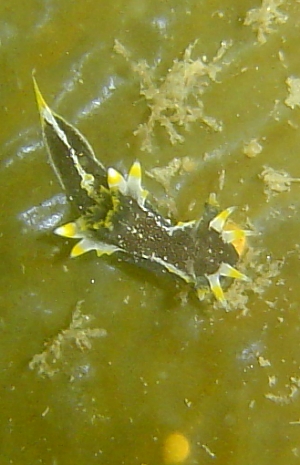
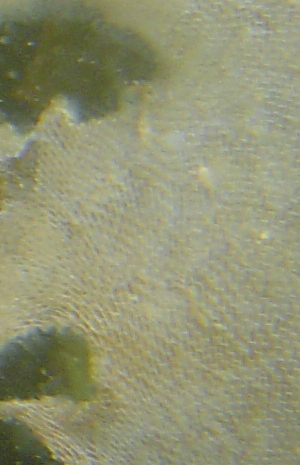
Dear Marty,
Yes this is P. hedgpethi. When I saw your photo I thought the Polycera was interested in the white encrusting bryozoan growing on the kelp, as can be seen in the right of your upper photo [and lower right close-up], but then I noticed the branching plant-like growths above and below the slug, which are the arborescent bryozoans this species feeds on.
Best wishes,
Bill Rudman
Polycera hedgpethi in Picton Harbour, New Zealand
December 13, 2006
From: Ashley Coutts
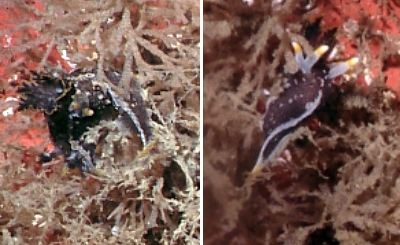
Dear Bill,
I have been using settlement plates in Picton Harbour, South Island, New Zealand for my PhD research and have discovered an unfamiliar nudibranch. I have some images of the species in question, but they are very poor quality because I have had to crop the image from larger images, so I'm hoping someone will recognise the species as being a common character.
Locality: Picton Harbour, Picton., 3 metres, South Island, New Zealand, Queen Charlotte Sound, 20 January 2005, Present grazing on Bugula flabellata on settlement plates beneath a wharf.. Length: Approximately 2-3 cm.. Photographer: Ashley Coutts.
Ashley Coutts
ashley.coutts@cawthron.org.nz
Coutts, A. D. M., 2006 (Dec 13) Polycera hedgpethi in Picton Harbour, New Zealand. [Message in] Sea Slug Forum. Australian Museum, Sydney. Available from http://www.seaslugforum.net/find/18983Dear Ashley,
This is Polycera hedgpethi. As you will see from the Fact Sheet, and acssociated messages, this is what we call a 'tramp' species or 'hitchhiker', and it seems to have taken advantage of world shipping to travel to many parts of the world. It feeds on Bugula and we suspect it travels on the bottom of ships or yachts with hulls fouled with this bryozoan. Larvae in ballast water is of course another alternative. The great mystery is where its real home is.
It has been known from New Zealand for many years (see Miller, 2001) but as far as I know, these earlier records refer to northern New Zealand, around Auckland. I guess it is not surprising to find it in Queen Charlotte Sound, but it is certainly valuable to get a verifiable sighting, with photos, to add to our knowledge of this species. Good luck with your research and any other opisthobranch finds you make are very welcome on the Forum
-
Miller, M.C. (2001) Descriptions of the Dorid nudibranchs Polycera hedgpethi Marcus, 1964 and P. fujitai Baba, 1937 in New Zealand (Gastropoda: Opisthobranchia). Journal of Molluscan Studies, 67: 489-497.
Bill Rudman
Polycera hedgpethi from San Diego
February 22, 2006
From: Mike Neubig
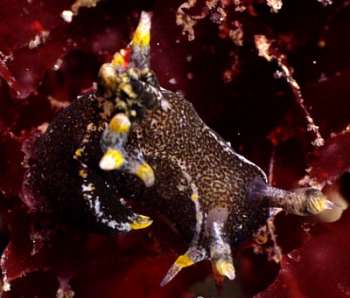
Hi Bill,
I noticed your comment to message #1113 "Well we only need messages from South Africa and California and we have most bases covered." Since all subsequent messages were non-Californian, I thought these photos of Polycera hedgpethi from San Diego might help close the gap.
Locality: La Jolla Shores, 16 m, California, USA, Eastern Pacific Ocean, 18 February 2006, sandy bottom. Length: 15 mm. Photographer: Mike Neubig.
Cheers,
Mike
mike.neubig@gmail.com
Neubig, M., 2006 (Feb 22) Polycera hedgpethi from San Diego. [Message in] Sea Slug Forum. Australian Museum, Sydney. Available from http://www.seaslugforum.net/find/15905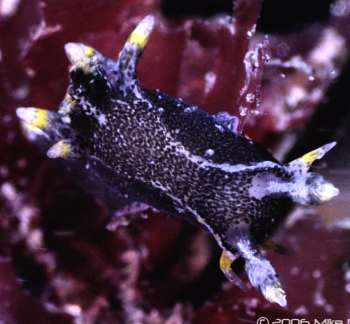
Dear Mike,
Thanks for sending The Forum these great photos. I should have done this a long time ago. Ernst Marcus named this species after marine biologist, and then Director of the Pacific Marine Station, Dillon Beach, California, Dr. Joel Hedgpeth in 1964. The original description was based on specimens from Tomales Bay. Since that time it has been observed throughout the Pacific and in the Atlantic, both tropically and temporally.
Where ever it is found, it is always on the branching bryozoan, Bugula. Maybe Terry Gosliner or Valda Frazer can send us a shot from South Africa.
Best wishes,
Dave Behrens
Re: Polycera hedgpethi from the Mediterranean
October 8, 2005
From: Mick Tait
Dear Egidio,
Concerning your message #14926:
I am interested in the water temperature when this photo was taken.
Thanks,
Mick Tait
mick@bluesphere.com.au
Tait, M, 2005 (Oct 8) Re: Polycera hedgpethi from the Mediterranean. [Message in] Sea Slug Forum. Australian Museum, Sydney. Available from http://www.seaslugforum.net/find/14949Polycera hedgpethi from the Mediterranean
October 7, 2005
From: Egidio Trainito
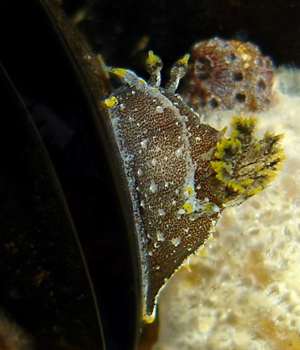
Is there anybody to identify this sea slug? It look like an Okenia.
Locality: Harbour, Italy, Mediterranean - Adriatic Sea. Depth: 2 m. Length: 1 cm. 29 Spetember 2005. On a mussel. Photographer: Filippo Ioni
Thanks
Egidio
et@egidiotrainito.it
Trainito, E., 2005 (Oct 7) Polycera hedgpethi from the Mediterranean. [Message in] Sea Slug Forum. Australian Museum, Sydney. Available from http://www.seaslugforum.net/find/14926Dear Egidio,
Can you give me a town to add to the locality please?
This is the well travelled Polycera hedgpethi. I only very recently posted a photo of it from Western Australia [message #14839], where I discussed its 'hitchhiking' way of life.
Best wishes,
Bill Rudman
Polycera hedgpethi research
October 3, 2005
From: Nerida Wilson
Hi Bill,
I think this is a good time to confess my interest in Polycera hedgpethi and other similar 'travelling' nudibranchs. Mick Tait and the WAM folks have been assisting me in gathering WA material. Dennis Hutson has also been incredibly helpful in monitoring a SA population. I am currently gathering material to look at global gene flow patterns, and would certainly appreciate any specimens (particularly from areas where it is less common) preserved in ethanol. The Sea Slug Forum certainly assists in attempting these types of projects, and I am very grateful
kind regards
Nerida
wilsong@auburn.edu
Wilson, N.G., 2005 (Oct 3) Polycera hedgpethi research. [Message in] Sea Slug Forum. Australian Museum, Sydney. Available from http://www.seaslugforum.net/find/14891Dear Nerida,
Glad to hear of your interest. It's valuable to know because it means that if we come across these animals in our fieldwork we know someone is working on them and there is some point in taking time to preserve them for DNA. All our collections are routinely preserved in formalin, although we now are building an ethanol preserved 'DNA' collection as well. If we find any of these hitch-hikers we will let you know.
Best wishes,
Bill Rudman
Re: Is this Polycera hedgpethi?
September 30, 2005
From: Mick Tait
Chris,
Concerning your message #14839:
We have collected a number of the P. hedgpethi for the WA Museum. The people at the museum, with the help of a P. hedgpethi specialist, are going to try and match the DNA and establish the origin of the population that appeared on the Rockingham Wreck Trail.
Kindest Regards,
Mick Tait
mick@bluesphere.com.au
Tait, M, 2005 (Sep 30) Re: Is this Polycera hedgpethi?. [Message in] Sea Slug Forum. Australian Museum, Sydney. Available from http://www.seaslugforum.net/find/14868Dear Mick,
I know we live in an age of specialisation - but a P. hedgpethi specialist? Do the tax payers know?
Joking aside, it would be interesting to look at the origins of a number of these hitch-hiking animals. Another candidate I have mentioned often isThecacera pennigera which is nominally considered a 'Nth Atlantic' species because it was described from there first. But it is found quite widely in the west Pacific where it is quite variable in colour pattern, while in the Atlantic it has only one colour form. From my understanding of genetics, that would suggest the Pacific is a more likely origin than the Atlantic. Please let us know if the specialists discover the origin of the P. hedgpethi population.
Best wishes,
Bill Rudman
Is this Polycera hedgpethi?
September 27, 2005
From: Chris Cunnold
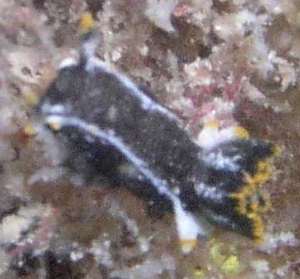
Dear Bill,
I came across this very bad photo from my very first underwater photo effort in January 2004. Is this Polycera hedgepethi? I've scanned all the books and cannot come up with anything else. If so, is it the rare find in Western Australia that all the books say it is?
Locality: Cockburn Sound, Western Australia, on Jetty Pylons. Depth: 6 m.
Length: 2.5 cm. 24 January 2004. Photographer: Chris Cunnold
Regards
Chris
cunnold@iinet.net.au
Cunnold, C., 2005 (Sep 27) Is this Polycera hedgpethi?. [Message in] Sea Slug Forum. Australian Museum, Sydney. Available from http://www.seaslugforum.net/find/14839Dear Chris,
Yes this is Polycera hedgpethi, quite dark but definitely that species. It is a bit hard to say if it is rare or common anywhere it is found because it is a not a 'stay-at-home' species. It is totally dependent on a particular bryozoan species on which it feeds. That bryozoan, Bugula, is what we call a fouling organism because it 'fouls' the bottom of boats. Fouling organisms usually have larvae in the plankton all the time and they are the first organisms to settle out of the plankton when a clean space becomes available on the sea bed, or boat's bottom, wharf pile, etc. They then grow to maturity bery quickly before they are eaten or crowded out by some other organism, which is a bit slower to settle but for various reasons is better at pushing out competitors was it gets going. So a fouling organism's main characteristics are its ability to quickly settle when a space becomes available, and then a rapid growth to maturity and production of the next generation and a short life. Animals which feed on fouling organisms, out of necessity have much the same life cycle. So its usually feast or famine. That's why you may find large populations of Polycera hedgpethi at a particular spot for a short period, and then none for years. I don't think describing that as 'rare' means much. perhaps 'intermittent' or 'spasmodic' would be better terms.
Best wishes,
Bill Rudman
Polycera hedgpethi - Cockburn Sound, W. Australia
July 13, 2005
From: Mick Tait
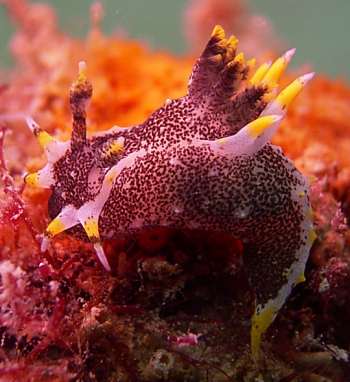
I have recently been shore diving the Bell Beach "Wreck Trail" located off Rockingham WA.
Locality: Bell Beach, Rockingham, Western Australia, Cockburn Sound.
Depth: 12 m. Length: varies 10 mm - 50 mm. 02 July 2005. Sandy bottom and along guide ropes. Photographer: Mick Tait
I have been specifically searching out and photographing Nudibranchs. It has become apparent that Polycera hedgpethi is one of the more common at this dive site. I would be interested to hear from others who may have encountered this species in Cockburn Sound.
Mick Tait
mick@bluesphere.com.au
Tait, M, 2005 (Jul 13) Polycera hedgpethi - Cockburn Sound, W. Australia. [Message in] Sea Slug Forum. Australian Museum, Sydney. Available from http://www.seaslugforum.net/find/14235Dear Mick,
Thanks for the record. It is not surprising it is found in an area like Cockburn Sound with its large port establishments. Polycera hedgpethi which has a worldwide distribution which is attributed to its feeding on the common fouling bryozoan Bugula, which has been spread around the world by shipping. It would be interesting to know if the population in Cockburn Sound is permanent. Usually it seems to appear in large numbers at a particular place and then disappears. It may not return to that particular spot for years. Like many of these 'tramp' species it is highly dependent on the presence of its food, which itself lives a precarious existence.
Best wishes,
Bill Rudman
Polycera hedgpethi from South Korea
June 11, 2005
From: Dong Bum Koh
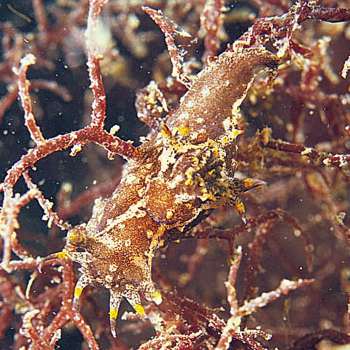
Dear Bill,
This is a photo of what I think is Polycera hedgpethi Marcus,1964.
Locality: Tong Young, Kyung Nam Province, South Sea of Korea, South Korea. Depth: 5 m. Length: About 20 mm. Dec. 1999. Photographer: Unknown. Photo Credit to Poong Deung Publishing company
Best regards,
Dong Bum Koh
drkoh@seasee.co.kr
Koh, D. B., 2005 (Jun 11) Polycera hedgpethi from South Korea. [Message in] Sea Slug Forum. Australian Museum, Sydney. Available from http://www.seaslugforum.net/find/13995Dear Koh,
This appears to be another new geographic record for this species.
Best wishes,
Bill Rudman
Re: Polycera hedgpethi from NSW, Australia
February 13, 2004
From: Juan Lucas Cervera
Dear Bill,
Concerning Dave Harasti's message [#12165] Polycera hedgpethi has been recorded in the Atlantic also.
• Caballer, M. and Ortea, J. 2002. Primera cita de Polycera hedgpethi Marcus, 1964 (Mollusca: Opisthobranchia) para la Peninsula Iberica. Noticiario SEM, 37: 55-56.
Regards.
Lucas.
lucas.cervera@uca.es
Cervera, J.L., 2004 (Feb 13) Re: Polycera hedgpethi from NSW, Australia. [Message in] Sea Slug Forum. Australian Museum, Sydney. Available from http://www.seaslugforum.net/find/12181Dear Lucas,
By mentioning the Mediterranean I was just trying to give Dave an idea of the scope of its distribution. There is a full distribution on the Fact Sheet which includes West Africa, Spain and the Mediterranean.
Cheers
Bill Rudman
Polycera hedgpethi from NSW, Australia
February 11, 2004
From: Dave Harasti
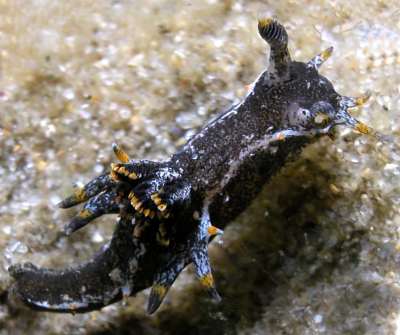
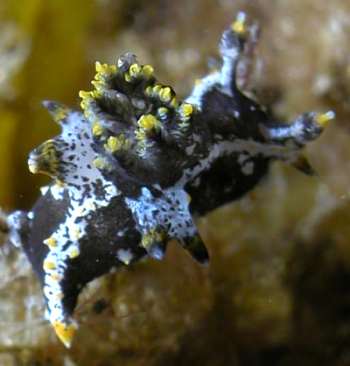
Hi Bill,
On February 8th 2004 I found this species whilst snorkelling the Tuross Estuary on the New South Wales south coast - Australia. The depth was only about 2 metres and I found two of them together and one individual. The water temperature was 24 degrees.
I have never seen this species before and couldn't identify it from the books. What species is it and is it very common?
Cheers,
Dave Harasti
www.daveharasti.com
diving@webone.com.au
Harasti, D., 2004 (Feb 11) Polycera hedgpethi from NSW, Australia. [Message in] Sea Slug Forum. Australian Museum, Sydney. Available from http://www.seaslugforum.net/find/12165Dear Dave,
This is Polycera hedgpethi. It seems to be one of those 'tramp' species which is turning up all around the world. It was first described from California, but is known from Australia, New Zealand, Sth Africa, Japan and the Mediterranean. It is a spasmodic visitor, when present it is often very abundant, but them can be absent for years.
Best wishes
Bill Rudman
Polycera hedgpethi from French Mediterranean
August 21, 2003
From: Marina Poddubetskaia
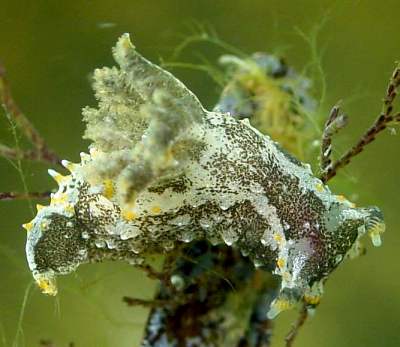
Dear Bill,
Here is a record of Polycera hedgpethi from Etang de Thau, which is a marine lake linked to Mediterranean coast. I saw several specimens of this species in this diving site, so I think it is quite common here.
Date: August 14, 2003
Location: Balaruc, Etang de Thau, France, Mediterranean coast. Depth: about 1m
Size: Upper Photo: 20mm. Lower Photo: 15mm.
Photos: Marina Poddubetskaia - Nembro website
Best wishes,
Marina.
nembro@nembro.info
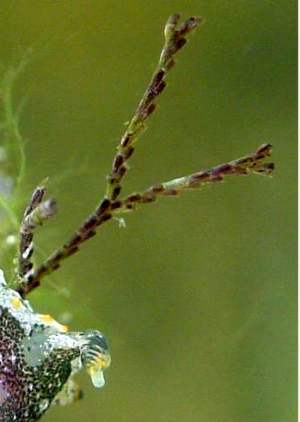
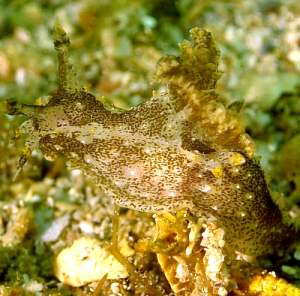
Thanks Marina,
It's good to get another record of this species from the Mediterranean. I have included a close-up of the bryozoan [lower left] it is crawling onm which is most probably Bugula sp. You mention seeing several specimens. These widespread 'tramp' species are often found in clusters, suggesting they are sometimes present in large numbers. However their distribution seems very patchy, clearly dependent on the right bryozoan colony being available when the nudibranch larvae are ready to settle out of the plankton.
Best wishes,
Bill Rudman
Re: Polycera hedgpethi from Spain
March 31, 2003
From: Juan Lucas Cervera
Dear Bill,
Regarding records of widespread polycerids, there is a recent record of Polycera hedgpethi in northern Spain by Caballer and Ortea (2002). This is the first record at the Iberian Peninsula coasts.
• Caballer, M. & Ortea, J. (2002) Primera cita de Polycera hedgpethi Marcus, 1964 (Mollusca: Opisthobranchia) para la Península Ibérica. Noticiario SEM, 37: 55-56.
Regards.
Lucas.
lucas.cervera@uca.es
Thanks Lucas,
Bill Rudman
Polycera hedgpethi from Japan.
August 6, 2002
From: Jun Imamoto
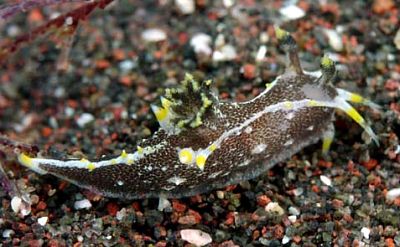
Dear Bill.
Here are some photos of Polycera hedgpethi from Japan.
Osezaki, Izu Peninsula, Suruga Bay, Japan, Depth: 15m, Temperature: 19C. Approx. 15mm long, 11 May 2002
Best Regards,
Jun Imamoto
http://umiushi.zive.net/
imamoto@wips.co.jp
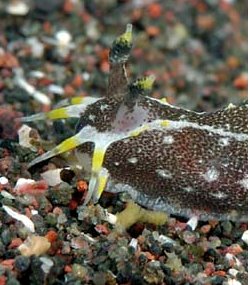
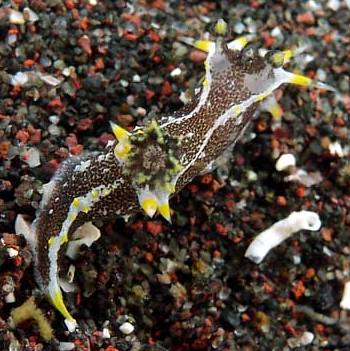
Thanks Jun,
This species certainly looks the same wherever it is found.
Bill Rudman
Re: Geographical range of Polycera hedgpethi
October 5, 1999
From: Juan Lucas Cervera
Hi Bill:
Reading the discussion about the colour variation of Thecacera pennigera, I have seen one of your replies in which you refer to the known geographical distribution of Polycera hedgpethi. This message is to tell you that this species has been also recorded in the Mediterranean Sea more than 10 years ago. This record was presented by other colleagues and me during the VIIth Malacological National Congress, held in Seville (October, 1988). Later, as result of that presentation, a paper was published about the redescription of this species based on the Mediterranean material (from Fusaro Lake, Naples, Italy):
•Cervera, J.L. et al. 1988 (1991). Polycera hedgpethi Marcus, 1964 (Gastropoda; Nudibranchia), una especie indopacifica descubierta en el Mediterraneo. Iberus, 8(2): 225-231.
This species is recorded, but misidentified, in Cattaneo-Vietti, Chemello and Giannuzzi-Savelli (1990) in their "Atlas of Mediterranean Nudibranchs", where they refer to this species as Polycera (Palio) dubia.
Regards.
Lucas.
lucas.cervera@uca.es
Cervera, J.L., 1999 (Oct 5) Re: Geographical range of Polycera hedgpethi. [Message in] Sea Slug Forum. Australian Museum, Sydney. Available from http://www.seaslugforum.net/find/1398Thanks Lucas,
Bill Rudman.
Polycera hedgpethi from New Zealand
July 24, 1999
From: Ross & Diane Armstrong
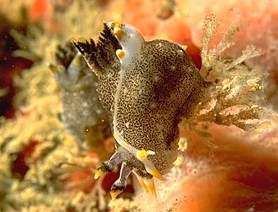
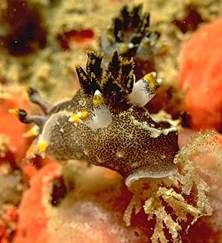
Dear Bill
During a night dive in Whangarei Harbour, [northern New Zeland], recently my friend Glenn Edney found the attached nudibranchs. Unfortunately Glenn's camera decided
not to work so the photos are by Diane and myself. Any idea of what it is?
Kind regards
Ross & Diane
ross@oceanwildlife.com
Armstrong, R. & D., 1999 (Jul 24) Polycera hedgpethi from New Zealand. [Message in] Sea Slug Forum. Australian Museum, Sydney. Available from http://www.seaslugforum.net/find/1111Dear Ross & Diane,
It looks like its a good time of year for Polycera hedgpethi in New Zealand at the moment as well as eastern Australia. See Peter Firminger's message from yesterday below! It also looks like it is in on its favoured food, the arborescent bryozoan Bugula.
Bill Rudman.
Talk about synchronicity!
July 24, 1999
From: Ross & Diane Armstrong
Hi Bill
I went on to your site to see if you have posted my message and the very first message on your list was of the same nudibranch Polycera hedgpethi but the message was posted by someone else. What is more that message has a reference to the other nudibranch Thecacera pennigera that we found on the same dive and had also sent to you.
I noticed that you were amazed by the first coincidence. I am more amazed still. You don't think these little nudibranchs are planning to take over the world do you?
Kind regards
Ross & Diane
ross@oceanwildlife.com
Dear Ross & Diane,
Well we only need messages from South Africa and California and we have most bases covered. Perhaps they are the Y2K Slug.
Bill Rudman.
Polycera hedgpethi
July 23, 1999
From: Betsey Hansen
When I try to open Polycera hedgpethi, I get Thecacera pennigera. Can you please correct your link.
Thanks,
Betsey.
elizabeth.p.hansen@chase.com
Dear Betsey,
The link to Thecacera pennigera was intentional when I did it, because at that stage the Forum didn't have its Search the Forum facility, and the only mention of Polycera hedgpethi was on the Thecacera pennigera Page. I have been meaning to do a page on Polycera hedgpethi, so your message has spurred me to action. If you have a look now you'll will find a brand new page.
If you have a research interest in Polycera hedgpethi the Forum would very much like a brief (or not so brief) account of your work.
Best wishes,
Bill Rudman.
I found my first seaslug!
July 23, 1999
From: Peter Firminger
Hi Bill,
I found (and collected) a sea slug and left it on your desk in a jar of seawater. Having helped set up this Forum and reading it nearly every day, I was getting frustrated in never having seen anything but photos of sea slugs. So I went down to the Spit (near Mosman in Sydney), leant over the side of a concrete pontoon floating in about 12m of water, and there they were!
There were egg spirals as well, on what I assume is a bryozoan.
What have I found?
Regards,
Peter Firminger
Web Manager
australian museum online
peterf@austmus.gov.au
Firminger, P., 1999 (Jul 23) I found my first seaslug!. [Message in] Sea Slug Forum. Australian Museum, Sydney. Available from http://www.seaslugforum.net/find/1105Dear Peter,
I can't believe it! What an amazing coincidence. Less than 10 minutes ago I posted a new page on Polycera hedgpethi in response to a message from Betsey Hansen.
If you look at the page you will see your animal is Polycera hedgpethi! For some reason they are quite often found during the winter months in Sydney Harbour. The photos I have posted from nearby Botany Bay were also taken in our southern winter.
Congratulations on your first nudibranch. In California I think that would entitle you to be known as a 'brancher'.
Bill Rudman.
1999 (Jul 23). Comment on I found my first seaslug! by Peter Firminger. [Message in] Sea Slug Forum. Australian Museum, Sydney. Available from http://www.seaslugforum.net/find/1105